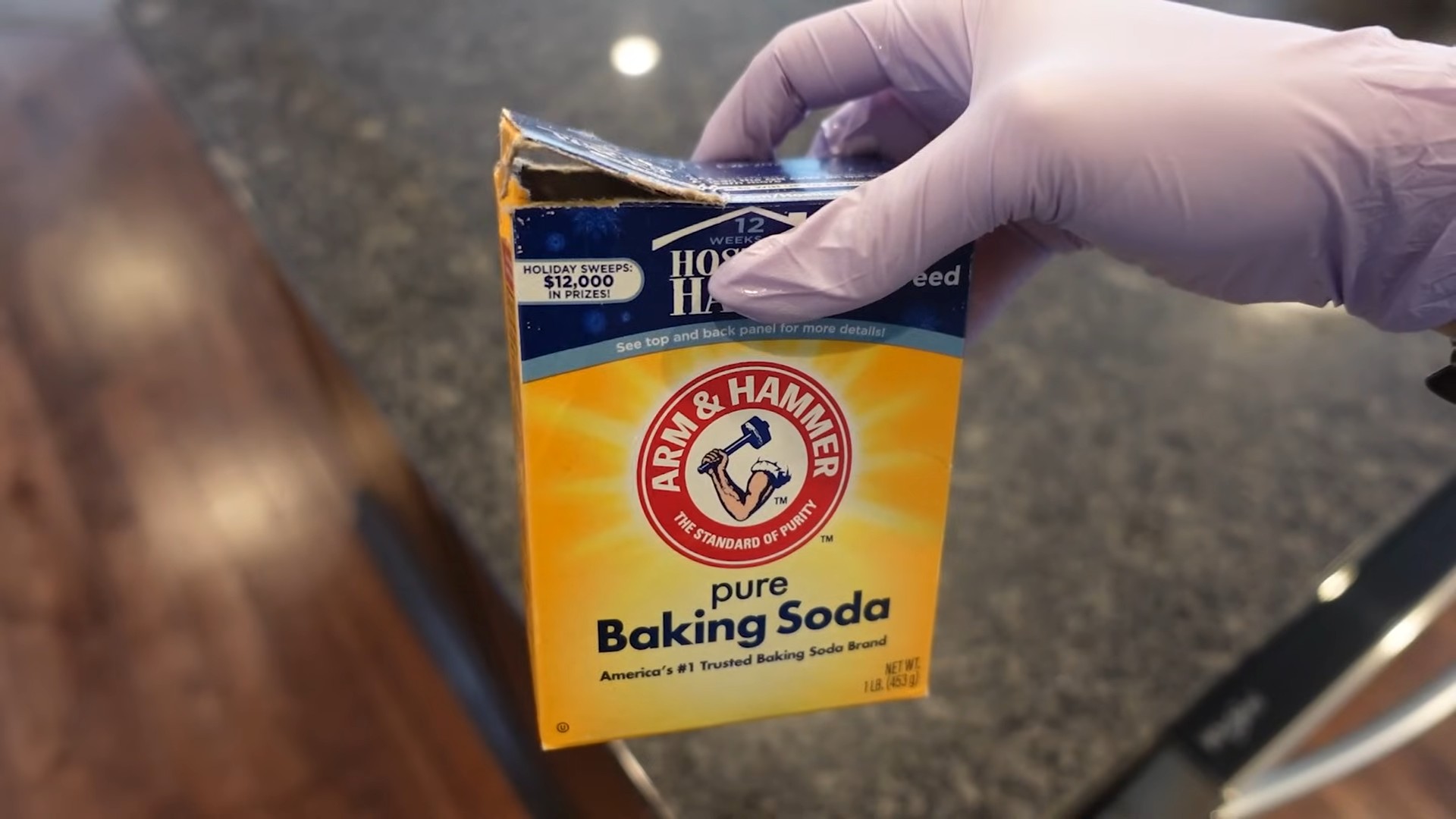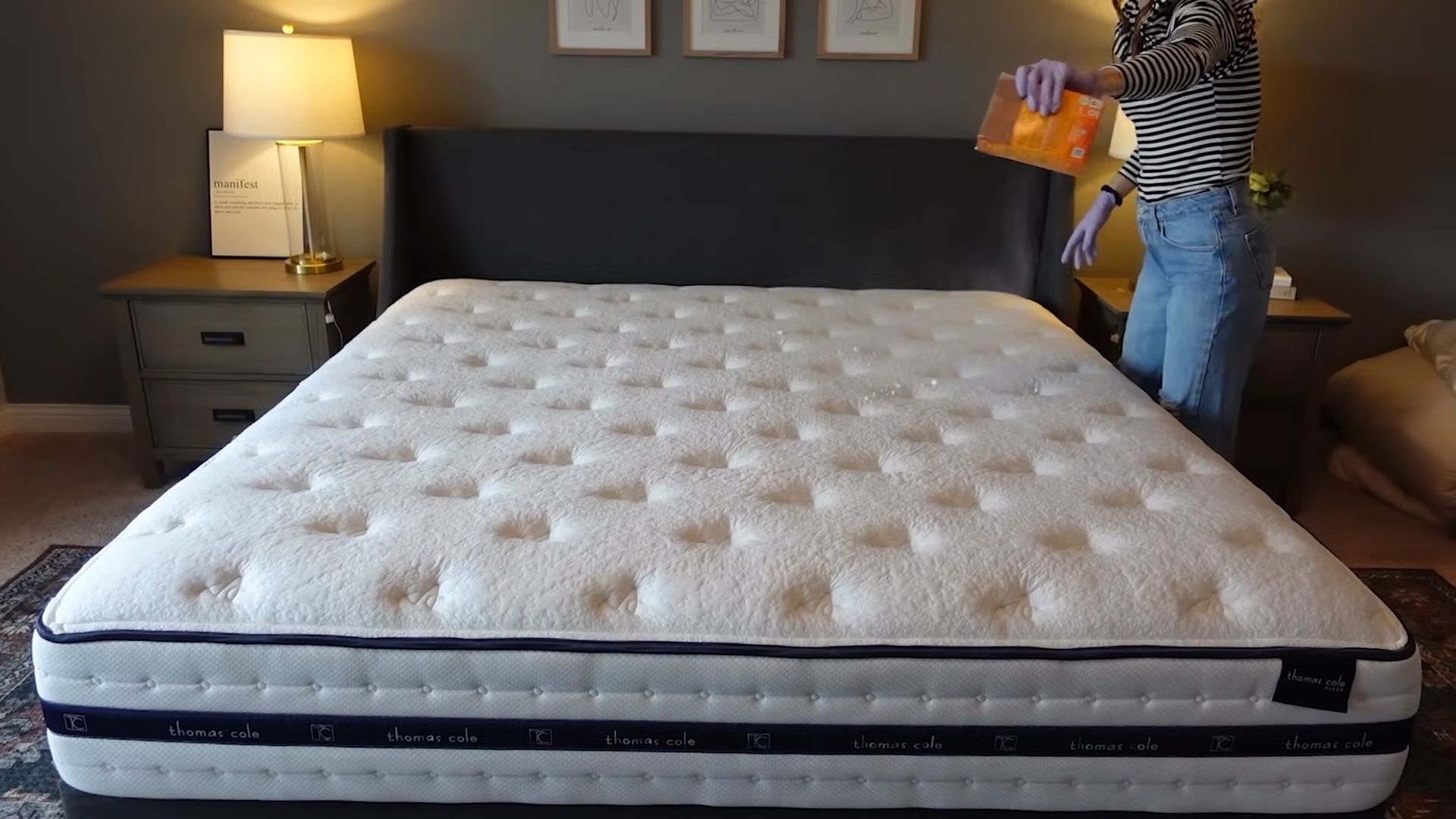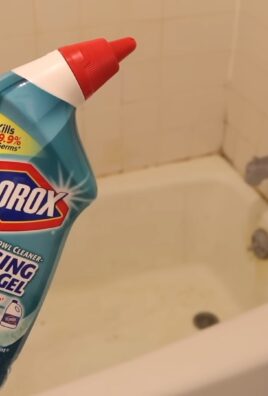Baking soda for clean bed: Who knew this humble kitchen staple could be your secret weapon for a fresher, cleaner sleep sanctuary? I’m always on the lookout for simple, effective, and budget-friendly ways to keep my home sparkling, and let me tell you, this one’s a game-changer. Forget expensive chemical cleaners – baking soda is here to revolutionize your bed cleaning routine!
For generations, baking soda has been a trusted household remedy, used for everything from baking (obviously!) to deodorizing refrigerators. Its cleaning prowess isn’t just a modern discovery; our grandmothers relied on it for its natural, gentle, yet powerful properties. Think of it as a time-tested secret passed down through the ages, now ready to be unleashed on your mattress.
Let’s face it, our beds are havens for dust mites, dead skin cells, and lingering odors. No matter how diligent we are with washing our sheets, these unwanted guests can still accumulate, impacting our sleep quality and even triggering allergies. That’s where this baking soda for clean bed trick comes in. It’s a simple, natural way to deep clean your mattress, banishing odors and creating a healthier sleep environment. I’m excited to share this easy DIY method that will leave you sleeping soundly and waking up refreshed!

DIY Deep Clean: Revitalize Your Mattress with Baking Soda
Okay, let’s be honest, when was the last time you *really* cleaned your mattress? We’re talking beyond just changing the sheets. Mattresses are magnets for dust mites, dead skin cells (gross, I know!), and lingering odors. But don’t worry, you don’t need to call a professional or buy expensive cleaning products. I’m going to show you how to deep clean your mattress using the power of baking soda – it’s cheap, effective, and you probably already have it in your pantry!
Why Baking Soda?
Baking soda, or sodium bicarbonate, is a natural deodorizer and mild abrasive. It works wonders on mattresses because:
* Odor Absorption: It neutralizes smells instead of just masking them. Think spilled coffee, pet accidents, or just general mustiness.
* Moisture Absorption: It helps draw out moisture trapped in the mattress, which can contribute to mold and mildew growth.
* Gentle Cleaning: It’s abrasive enough to lift dirt and grime without damaging the mattress fibers.
* Eco-Friendly: It’s a natural and non-toxic alternative to harsh chemical cleaners.
What You’ll Need
Before we get started, gather these supplies:
* Baking Soda: The star of the show! You’ll need a generous amount, depending on the size of your mattress. A large box should suffice for a queen or king.
* Vacuum Cleaner with Upholstery Attachment: A powerful vacuum is essential for removing the baking soda and all the gunk it lifts. Make sure you have the upholstery attachment for better suction and to avoid damaging the mattress.
* Sieve or Flour Sifter (Optional): This helps distribute the baking soda evenly over the mattress.
* Essential Oils (Optional): If you want to add a fresh scent, a few drops of your favorite essential oil (like lavender or eucalyptus) can be mixed with the baking soda.
* Spray Bottle (Optional): For tackling stains, you might need a spray bottle filled with a solution of equal parts water and white vinegar.
* Clean Cloths or Sponges: For blotting stains.
* Rubber Gloves (Optional): To protect your hands, especially if you’re using a stain remover.
Step-by-Step Mattress Cleaning Guide
Here’s the breakdown of how to get your mattress sparkling clean:
Phase 1: Preparation is Key
1. Strip the Bed: Remove all bedding, including sheets, blankets, comforters, and mattress protectors. Wash them according to their care instructions. This is a great opportunity to give your bedding a thorough cleaning as well.
2. Open the Windows: Ventilation is crucial! Open windows and doors to allow fresh air to circulate and help the baking soda work its magic. The more airflow, the better.
3. Protect Yourself (Optional): If you have sensitive skin, consider wearing rubber gloves.
4. Spot Treat Stains (If Necessary): Before applying the baking soda, address any visible stains.
* For Urine Stains: Blot up as much of the urine as possible with a clean cloth. Then, mix equal parts water and white vinegar in a spray bottle. Lightly spray the stain and let it sit for 5-10 minutes. Blot again with a clean cloth until the stain is gone.
* For Blood Stains: Use cold water and a clean cloth to blot the stain. Avoid using hot water, as it can set the stain. You can also try using a paste of baking soda and water to gently scrub the stain.
* For Other Stains: Experiment with different stain removal methods, but always test them in an inconspicuous area of the mattress first to ensure they don’t damage the fabric.
Phase 2: Baking Soda Application
1. Even Distribution is Important: Pour baking soda into a sieve or flour sifter. This will help you distribute it evenly over the entire surface of the mattress. If you don’t have a sieve, you can sprinkle it by hand, but try to be as consistent as possible.
2. Generous Coverage: Don’t be shy! You want a thin, even layer of baking soda covering the entire mattress. Pay special attention to areas that tend to accumulate more moisture or odors, such as where you sleep or where pets might have slept.
3. Add Essential Oils (Optional): If you’re using essential oils, add a few drops to the baking soda before applying it to the mattress. Mix well to distribute the oil evenly. Lavender, eucalyptus, and tea tree oil are great choices for their antibacterial and deodorizing properties. I personally love lavender for a calming scent.
Phase 3: The Waiting Game (and the Magic Happens!)
1. Patience is a Virtue: This is the most important step! Let the baking soda sit on the mattress for at least 4-8 hours, or even better, overnight. The longer it sits, the more time it has to absorb odors and moisture.
2. Keep the Room Ventilated: Continue to keep the windows open during this time to maximize the effectiveness of the baking soda.
3. Resist the Urge to Vacuum Early: I know it’s tempting to vacuum it up right away, but trust me, the waiting period is crucial.
Phase 4: Vacuuming and Final Touches
1. Thorough Vacuuming: Using your vacuum cleaner with the upholstery attachment, thoroughly vacuum the entire surface of the mattress. Go over each area multiple times to ensure you remove all the baking soda.
2. Pay Attention to Crevices: Don’t forget to vacuum the sides and edges of the mattress, as well as any crevices or seams where dust and debris can accumulate.
3. Empty the Vacuum Bag or Canister: After vacuuming, empty the vacuum bag or canister to prevent the baking soda from clogging it.
4. Flip the Mattress (If Possible): If your mattress is flippable, flip it over and repeat the entire process on the other side. This will ensure that both sides are thoroughly cleaned and deodorized.
5. Air it Out: After vacuuming, let the mattress air out for a few more hours before making the bed. This will help remove any lingering baking soda dust and allow the mattress to fully dry.
Tips and Tricks for a Super Clean Mattress
* Use a Mattress Protector: A mattress protector is a worthwhile investment. It acts as a barrier against spills, stains, dust mites, and allergens, extending the life of your mattress and making it easier to keep clean.
* Vacuum Regularly: Vacuum your mattress every few months to prevent dust and debris from building up.
* Rotate Your Mattress: Rotate your mattress every 6 months to prevent uneven wear and tear.
* Sunlight is Your Friend: If possible, expose your mattress to direct sunlight for a few hours. Sunlight has natural disinfecting properties and can help kill bacteria and mold. Just be careful not to leave it in direct sunlight for too long, as it can damage the fabric.
* Address Accidents Immediately: The sooner you address spills and accidents, the easier they will be to clean.
* Consider Professional Cleaning: For heavily soiled or stained mattresses, consider hiring a professional mattress cleaning service. They have specialized equipment and cleaning solutions that can effectively remove stubborn stains and odors.
* For Memory Foam Mattresses: Be extra gentle when cleaning memory foam mattresses. Avoid using harsh chemicals or excessive moisture, as they can damage the foam.
Troubleshooting
* Baking Soda Residue: If you find that there’s still baking soda residue after vacuuming, try vacuuming again with a clean upholstery attachment. You can also use a damp cloth to gently wipe the surface of the mattress, but be careful not to over-wet it.
* Lingering Odors: If you still notice lingering odors after cleaning, try repeating the baking soda treatment. You can also try using a stronger deodorizer, such as activated charcoal.
* Stain Won’t Come Out: Some stains are simply too stubborn to remove with DIY methods. In these cases, you may need to consult a professional cleaning service.
By following these steps, you can easily deep clean your mattress with baking soda and enjoy a cleaner, fresher, and more comfortable sleep. Happy cleaning!

Conclusion
So, there you have it! This simple yet incredibly effective DIY trick using baking soda for clean bed linens and mattresses is a game-changer for anyone seeking a fresher, healthier sleep environment. We’ve explored how this humble household staple can banish odors, absorb moisture, and even help to eliminate dust mites, all without the harsh chemicals found in many commercial cleaning products.
Why is this a must-try? Because a clean bed is more than just aesthetically pleasing; it’s crucial for your overall well-being. A build-up of dust, allergens, and odors can disrupt your sleep, exacerbate allergies, and even contribute to skin irritations. By incorporating this baking soda method into your regular cleaning routine, you’re actively investing in a better night’s rest and a healthier lifestyle.
But the beauty of this DIY trick lies in its adaptability. Feel free to experiment with different essential oils to create a personalized scent that promotes relaxation and sleep. Lavender, chamomile, and eucalyptus are all excellent choices. You could also add a small amount of borax to the baking soda mixture for an extra boost of cleaning power, especially if you’re dealing with stubborn stains or odors. Remember to always test a small, inconspicuous area first to ensure colorfastness.
Don’t be afraid to adjust the frequency of this cleaning method to suit your individual needs and lifestyle. If you have pets that sleep on your bed, or if you live in a humid climate, you may want to use baking soda more frequently. Conversely, if you maintain a very clean bedroom and don’t have any pets, you may only need to do this every few months.
We are confident that once you experience the difference a baking soda refresh can make, you’ll never go back to relying solely on traditional cleaning methods. The results are undeniable: a fresher, cleaner, and more inviting bed that promotes restful sleep and overall well-being.
We wholeheartedly encourage you to try this simple yet powerful DIY trick for yourself. And more importantly, we want to hear about your experience! Share your results, variations, and any tips you discover in the comments section below. Let’s create a community of clean-bed enthusiasts and help each other achieve the ultimate sleep sanctuary. Your feedback is invaluable and will help others discover the transformative power of baking soda for clean bed linens and mattresses. So go ahead, give it a try, and let us know what you think! You might be surprised at how much of a difference this simple solution can make.
Frequently Asked Questions (FAQ)
1. How often should I use baking soda to clean my bed?
The frequency depends on your individual needs and lifestyle. As a general guideline, we recommend using baking soda to clean your mattress and bed linens every 1-3 months. If you have pets that sleep on your bed, suffer from allergies, or live in a humid environment, you may want to increase the frequency to once a month or even every few weeks. Conversely, if you maintain a very clean bedroom and don’t have any pets, you may only need to do this every 3-6 months. Pay attention to any lingering odors or signs of dust build-up, and adjust your cleaning schedule accordingly.
2. Can I use baking soda on all types of mattresses?
Baking soda is generally safe for most types of mattresses, including innerspring, memory foam, and latex mattresses. However, it’s always a good idea to check the manufacturer’s instructions or warranty information before using any cleaning product on your mattress. For memory foam mattresses, be sure to use a vacuum cleaner with a brush attachment to avoid damaging the foam. If you have any concerns, test the baking soda on a small, inconspicuous area of the mattress first to ensure that it doesn’t cause any discoloration or damage.
3. What kind of baking soda should I use?
Plain, unscented baking soda is the best option for cleaning your bed. Avoid using baking powder, which is a different product with different properties. You can find baking soda in most grocery stores and pharmacies. Look for a brand that is specifically labeled as “baking soda” or “sodium bicarbonate.”
4. Can I add essential oils to the baking soda?
Yes, adding essential oils to the baking soda can enhance the cleaning process and create a pleasant scent. Lavender, chamomile, eucalyptus, and tea tree oil are all excellent choices for promoting relaxation and sleep. Simply add a few drops of your favorite essential oil to the baking soda and mix well before sprinkling it on your mattress. Be sure to use high-quality, pure essential oils for the best results. If you are sensitive to scents, start with a very small amount of essential oil and gradually increase it until you achieve the desired fragrance.
5. How long should I leave the baking soda on my mattress?
For optimal results, leave the baking soda on your mattress for at least 30 minutes, but preferably for several hours or even overnight. The longer the baking soda sits on the mattress, the more time it has to absorb odors, moisture, and dust mites. If you’re dealing with stubborn odors or stains, you may want to leave the baking soda on for up to 24 hours. Just be sure to vacuum it up thoroughly afterwards.
6. What kind of vacuum cleaner should I use?
A vacuum cleaner with a strong suction and a brush attachment is ideal for removing baking soda from your mattress. The brush attachment will help to loosen the baking soda and lift it from the fibers of the mattress. If you have a handheld vacuum cleaner, that can also work well for smaller areas. Be sure to empty the vacuum cleaner bag or canister after vacuuming up the baking soda to prevent it from clogging the machine.
7. Can I use this method on other bedding items, such as pillows and comforters?
Yes, you can use baking soda to clean other bedding items, such as pillows and comforters. For pillows, sprinkle baking soda on both sides and let it sit for at least 30 minutes before vacuuming it off. For comforters, you can sprinkle baking soda on the surface and let it sit for a few hours before washing it according to the care instructions. Always check the care label before cleaning any bedding item to ensure that it is safe to use baking soda.
8. What if I don’t have a vacuum cleaner?
While a vacuum cleaner is the most effective way to remove baking soda from your mattress, you can also use a stiff brush to sweep it off. Be sure to brush in the direction of the fabric fibers to avoid damaging the mattress. You may need to repeat the brushing process several times to remove all of the baking soda. Alternatively, you can use a damp cloth to wipe away the baking soda, but be careful not to over-wet the mattress.
9. Is baking soda safe for people with allergies or asthma?
Baking soda is generally considered safe for people with allergies or asthma, as it is a natural and non-toxic cleaning agent. However, some people may be sensitive to baking soda, so it’s always a good idea to test it on a small area first. If you experience any irritation or allergic reaction, discontinue use. If you have severe allergies or asthma, consult with your doctor before using baking soda to clean your bed.
10. Will baking soda remove stains from my mattress?
Baking soda can help to lighten some stains, but it may not completely remove all types of stains. For best results, treat stains as soon as possible. Make a paste of baking soda and water, apply it to the stain, and let it sit for at least 30 minutes before blotting it with a clean cloth. You may need to repeat this process several times to remove the stain. For stubborn stains, you can try adding a small amount of hydrogen peroxide to the baking soda paste. Always test any cleaning solution on a small, inconspicuous area of the mattress first to ensure that it doesn’t cause any discoloration or damage.




Leave a Comment